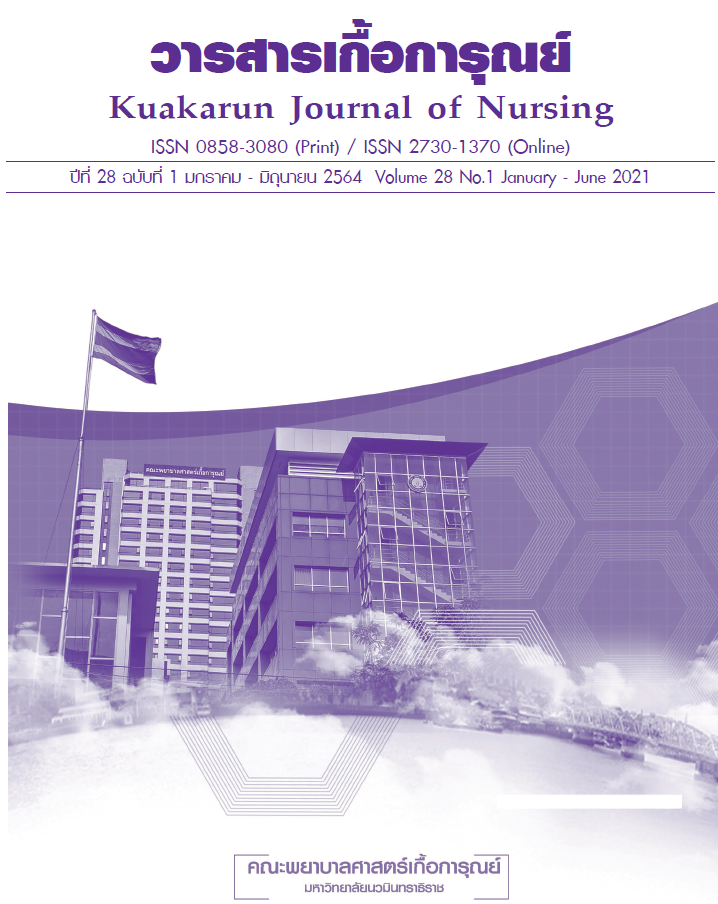Factors Predicting Condom Use Intention among Men Who have Sex with Men Students
Keywords:
Intention, Men who have sex with men, Condom, Sexually Transmitted Diseases, Human Immunodeficiency VirusAbstract
The descriptive predictive research aimed to study condom use intention among men who have sex with men students and identify its predictors from attitude toward condom use, subjective norms and perceived behavioral control. Totally, 182 students were selected from 2 universities in Bangkok by snowballing sampling technique. Data were collected using demographic data form attitude toward condom use questionnaire, the subjective norm questionnaire, the perceived behavioral control questionnaire, and the intention to condom use questionnaire. All the questionnaires were assessed for content validity index by five experts. The Cronbach's alpha coefficients were .85, .93, .93 and .73, respectively. Data were analyzed using stepwise multiple regressions.
This research study revealed as the following results: The average score of intention to condom use of men who have sex with men was at medium level ( = 4.01, S.D = 1.32). The attitudes toward condom use (β = .35) and subjective norms (β = .24) were significant predictors of intention condom use (p-value < .05). There were 29.70% of the variance of condom use intention among men who have sex with men students. Therefore, perceived behavioral control was not a significant predictor. Furthermore, this study should conduct experimental research.
References
Piyakul P. HIV / AIDS in a group of men who have sex with men, Bureau of AIDS,TB and STIs [Internet]. 2012 [cited 2017 Aug 25]. Available from: http://aidssti.ddc.moph.go.th/contents/download/740 (in Thai)
Pongtriang P, O'Brien AP, Maguire J. Sexual diversity and social stigma on HIV prevention for Thai gay men. Australian Nursing and Midwifery Journal 2015;23(5):34.
Andrew BJ, Mullan BA, Wit de JB, Monds LA, Todd J, Kothe EJ. Does the theory of planned behaviour explain condom use behaviour among men who have sex with men? a meta-analytic review of the literature. AIDS and Behavior 2016;20(12):2834-44.
Sookrak N, Srisuriyawate R, Homsin P. Predicted factors of consistent condom use among men who have sex with men (MSM) undergraduate students in higher education institutions Chonburi province. Journal of Public Health Nursing 2018;32(3):83-100. (in Thai)
Bureau of AIDS TB and STIs. Summary of AIDS situation and HIV infection in Thailand 2017 [Internet]. 2017 [cited 2017 Aug 25]. Available from: https://ddc.moph.go.th/uploads/publish/1038320200818060101.pdf (in Thai)
Bureau of AIDS TB and STIs. Action plan for the prevention and solution of AIDS and sexually transmitted diseases 2017-2021 [Internet]. 2017 [cited 2017 Aug 25]. Available from: 203.157.196.7/web_ssj/webmanager/uploads/2018-03-081052471.แผนงานควบคุมโรคเอดส์.pdf (in Thai)
Bureau of AIDS TB and STIs. Summary of the situation of AIDS patients and HIV infection in Thailand, 2015 [Internet]. 2017 [cited 2017 Aug 25]. Available from: http://aidssti.ddc.moph.go.th/contents/view/1650 (in Thai)
Division of Student Affairs Mahasarakham University. MSU campaign to provide knowledge about AIDS, early detection, early treatment, ending AIDS. 2016 [cited 2017 Aug 25]. Available from: http://www.web.msu.ac.th/ssystem/msuhotnews/detailnews.php?hm=&hotnewsid=6902&uf=&qu= (in Thai)
Workowski KA, Bolan GA. Sexually transmitted diseases treatment guidelines, 2015. Morbidity and Mortality Weekly Report 2015;64(3):1-137.
Kalichman SC, Picciano JF, Roffman RA. Motivation to reduce HIV risk behaviors in the context of the information, motivation and behavioral skills (IMB) model of HIV prevention. Journal of Health Psychology 2008;13(5):680-9.
Thato R, Daengsaard E. Determinants of behavior change intention among heterosexual Thai males diagnosed with sexually transmitted diseases. AIDS Patient care and STDs 2016;30(11):512-8.
Thurman AR, Holden AE, Shain RN, Perdue S, Piper JM. Preventing recurrent sexually transmitted diseases in minority adolescents: a randomized controlled trial. Obstetrics & Gynecology 2008;111(6):1417-25.
Fishbein M, Ajzen I. Predicting and changing behavior: the reasoned action approach. New York: Psychology Press; 2010.
Sheeran P, Orbell S. Do intentions predict condom use? meta-analysis and examination of six moderator variables. British Journal of Social Psychology 1998;37(2):231-50.
Levina M, Dantas G, Fishbein M, Haeften VI, Montano D. Factors influencing MSMs' intentions to always use condoms for vaginal, anal and oral sex with their regular partners. Psychology, Health & Medicine 2001;6(2):191-206.
Phoka S. Sexual behaviors and determinants of intention to use condoms to prevent HIV infection among male adolescents [Dissertation]. Chiang Mai: Chiang Mai University; 1998. (in Thai)
Cohen J. Statistical power analysis for the behavioral sciences. 2nd ed. New York: Erlbaum Associates; 1988.
Thato R. Nursing research : concepts to application. 4th ed. Bangkok: Chulalongkorn University; 2018. (in Thai)
Buunk BP, Bakker AB, Siero FW, van den Eijnden RJ, Yzer MC. Predictors of AIDS-preventive behavioral intentions among adult heterosexuals at risk for HIV-infection: extending current models and measures. AIDS Education and Prevention 1998;10(2):149-72.
Thato S, Charron-Prochownik D, Dorn LD, Albrecht SA, Stone CA. Predictors of condom use among adolescent Thai vocational students. Journal of Nursing Scholarship 2003;35(2):157-63.
Mothong A, Keeratimethakul A, Lertwatchara A. Attitude toward behavior, subjective norms, intention, condom intention to use in middle adolescents : a study of theory of reasoned action [Dissertation]. Bankok: Chulalongkorn University; 2013. (in Thai)















